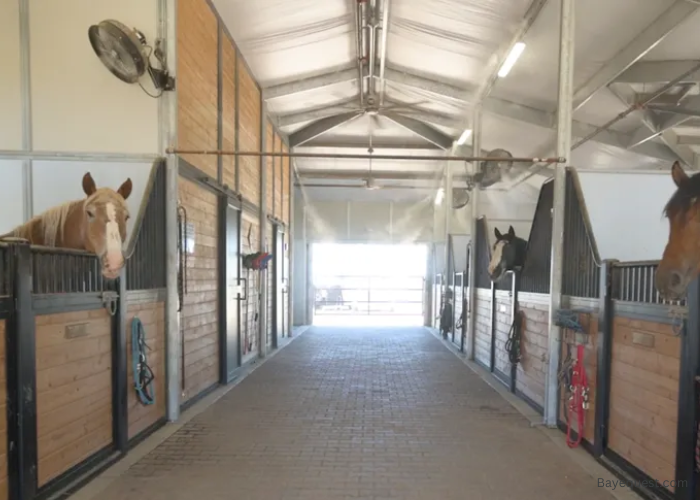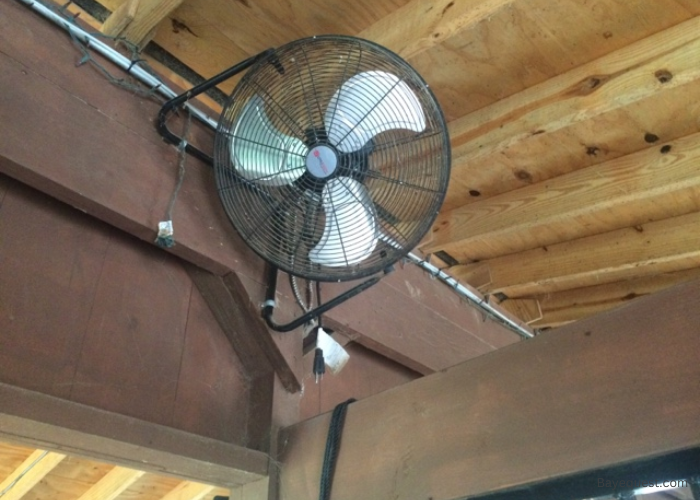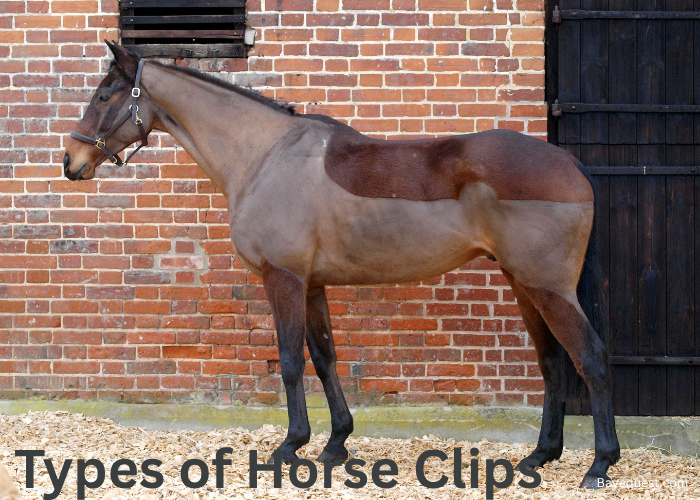When the threat of summer heat or stale air looms over your horse’s health and comfort, a quality stall fan becomes a necessity.
Proper air circulation isn’t just about controlling dust and reducing moisture. It’s about preventing dangerous heat stress and creating a healthy environment for your horses.
Whether you manage a bustling stable or a cozy barn, investing in a durable fan is a smart way to protect your horses.
In this guide, you’ll discover the best fans for horse stalls and get practical tips to keep your barn fresh and comfortable.
Best Fans for Horse Stalls: Key Takeaway
1. Best Premium Performance Fan – VENTISOL 20-Inch Waterproof Wall Mount Fan
2. Best for Large Setups – J&D Mfg. Agricultural EZ Breeze Basket Fan
3. Best Stall-Rated Fan – Tornado 24-Inch High Velocity Wall Mount Fan
4. Best Budget Option – CCGIRU 5400 CFM 20” Outdoor Wall Mount Fan
5. Best DIY-Friendly Fan – BEESTAR 20-Inch High Velocity Wall Mount Fan
6. Best Wall Mount Fan – VINICAYA 20-Inch Industrial Wall Mount Fan
7. Best Exhaust Fan – iLiving 10” Wall Mounted Shutter Exhaust Fan
Understanding Horse Stall Ventilation
Fresh air is paramount for your equine’s health. Horses produce moisture from their sweat, breath, and even manure. This moisture builds up fast, especially in enclosed stalls.
With poor air circulation, ammonia fumes and dust particles linger in the air. Failure to address this creates an unhealthy environment that irritates their respiratory system. Additionally, it may trigger skin problems.
However, with proper ventilation, you can ensure a steady airflow that replaces stale air with clean, fresh air.
This is particularly vital for horses in heavy work, as consistent ventilation helps them to cool down and recover from exercise. More importantly, it helps your horse stay calm even in the most sweltering weather conditions.
Your stall’s ventilation needs depend on its size and layout. Additionally, you’ll want to factor in the number of horses housed and the general climate. Open-front design stalls trap less moisture and heat than barns with solid walls.
Besides improving air quality, good ventilation limits mold growth and discourages pests. Therefore, consider installing a purpose-built fan to supplement your stall’s natural ventilation.

Types of Fans Suitable for Horse Stalls
Not every fan is suited for your horse barn. It’s crucial to understand your specific needs. The size and layout of your stall and the number of horses housed determine the best option for you.
Ceiling fans
These fans are the go-to option if your barn has higher ceilings. They ensure gentle air circulation, maintaining a favorable environment for your beloved animals.
You can leave a ceiling fan running nonstop without creating dangerous turbulence.
Circulation fans
Circulation fans are mounted on posts or walls to direct airflow to specific areas of the barn. They include a powerful motor that generates high-velocity air to boost airflow.
Circulation fans come with tilt features to target air exchange in specific areas.
Misting fans
Misting fans are a lifesaver, especially for those living in hot, dry regions. These fans combine water mist with high-velocity airflow to improve evaporative cooling.
Misting fans are particularly helpful during peak summer temperatures. However, the moisture may encourage mold growth or make the floor slippery.
Box fans
If you’re working with a budget, a box fan will suit most of your horse stall’s needs. They’re lightweight and portable and mount easily.
Unfortunately, most residential-grade box fans lack waterproofing features. So, they create a safety hazard in humid and dusty environments. Use only a UL-listed box fan rated for agricultural use.
Exhaust fans
These fans maintain airflow in tightly sealed structures. They pull warm, stale air out of the stall. The resulting vacuum creates a negative pressure, drawing fresh air in. Exhaust fans are suited for large barns to supplement the natural cross-ventilation.
Key Features to Look for in Horse Stall Fans
Each horse stall faces unique challenges, from moisture and dust to smelly odors. Here’s what to keep in mind to ensure you pick an efficient horse stall fan.
Durability and weather resistance
In harsh barn environments, you want a rugged fan that can withstand heavy, long-term use. Your fan should have sealed motors, sturdy blade guards, and rust-resistant finishes.
Additionally, the model should be weather-resistant to prevent electrical failures or corrosion.
Safety features
Horses are naturally curious, so you’ll want to ensure their safety in the stall. The best fans come with overload-protection motors, secure mounting brackets, and protective grills.
If your fan is ETL or UL-certified, it meets key fire and electrical safety standards.
Noise level
While a powerful motor moves massive air volumes, the noise will startle your horse. Ensure that your fan’s decibel rating isn’t overkill for stall settings.
Energy efficiency
Running your fan nonstop can result in a massive electricity bill. So, you’ll want an energy-efficient device. Variable-speed control and high-efficiency motors help manage power consumption.
Size and airflow capacity
We measure fan performance in cubic feet per minute (CFM). Your fan’s CFM should match your stall’s size and ventilation needs.
While excess airflow creates bothering drafts, minimal ventilation won’t tackle heat buildup.
Ease of installation and maintenance
Rearing and handling horses is a hard task. So, your fan shouldn’t add up to your workload. Choose a device that mounts and cleans easily.
The ideal model should have washable blade guards and simple mounting brackets.

7 Best Fans For Horse Stalls: Product Reviews
1. Best Premium Performance Fan – VENTISOL 20-Inch Waterproof Wall Mount Fan
If you’re looking for a fan that can withstand harsh barn environments, the Ventisol is hard to beat. Its dual ball-bearing motor is IPX4-rated, making it waterproof and long-lasting.
It’s also ETL certified for safety. Its 3-speed metal blade system creates an impressive air velocity of 4,650 CFM. This airflow is sufficient to aerate your horse stall regardless of its size.
This model’s 180-degree vertical tilt helps direct breezes to areas prone to heat. Additionally, its rugged housing is reinforced with safety grills, ensuring the safety of your horse.
Owners love it for its quiet yet powerful performance. It has a sturdy build, making it heavy. So, anchor it using wall studs.Luckily, it’s plug-and-play and arrives fully assembled.
This product is a top-tier choice for equestrians in need of premium airflow and peace of mind.
Pros
- Its sturdy build makes it long-lasting
- It’s powerful enough for high-ventilation needs
- It’s easy to assemble and install
- This product operates quietly
Cons
- It’s heavy, requiring additional support
- The electric cord often gets in the way
2. Best for Large Setups – J&D Mfg. Agricultural EZ Breeze Basket Fan
When you need airflow across bigger barns or multiple stalls, the J&D EZ Breeze basket fan delivers.
This is a heavy-duty unit, pushing up to 1700 CFM of air through its cylindrical basket design. Despite the powerful airflow, it operates quietly without startling sensitive horses.
Also, it boasts robust aluminum blades and a powder-coated steel cage. It’s also waterproof and is OSHA and UL listed for safety.
While it lacks variable speed control, the airflow is sufficient for most equestrian facilities. It cools and dries your stall without a fuss.
This agriculture-grade fan is simple to install. It comes with a sturdy mount that withstands daily rugged use.
Horse handlers appreciate the balance mix of durability, performance, and noiseless operation. You’ll also love its modern build and exhaust properties.
Pros
- It runs quietly
- It’s waterproof and long-lasting
Con
- It lacks a variable speed setting
3. Best Stall-Rated Fan – Tornado 24-Inch High Velocity Wall Mount Fan
The Tornado 24-inch wall mount fan is for handlers who need high-velocity airflow in their stalls. This product delivers 7,700 CFM of air movement to cool even the hottest barn.
Its variable speed settings allow you to lower the output to 5,850 or 6600 CFM, depending on your cooling needs.
This feature makes the fan ideal for use in agricultural, residential, and commercial settings. However, this fan isn’t suited for outdoor weather exposure.
The unit is durable, featuring a powder-coated steel housing and aluminum blades. So, you needn’t worry about dust, debris, and barn grime.
Even more impressive is its low noise output. At 69 decibels, this product boasts the latest noise-reduction technology.
The fan head can tilt 180 degrees vertically, allowing you to direct airflow anywhere. Its frustration-free mounting and long power cord make this product adaptable to different stall layouts.
Whether it’s a stable or large barn, the Tornado delivers power and versatility in one package.
Pros
- Setup is easy and hassle-free
- It’s suitable for large stalls
- It includes 3 speed settings
- It’s less noisy
Con
- Power consumption is high
4. Best Budget Option – CCGIRU 5400 CFM 20” Outdoor Wall Mount Fan
With the CCGIRU outdoor fan, you don’t need to break the bank to keep your stable cool. This IPX4-listed fan can withstand dust, humidity, and light rain.
Its industrial motor delivers up to 5,400 CFM in high mode. With its dynamic airflow, you can adjust the speed to 4,300 CFM or 3,900 CFM, depending on your needs.
In high-speed mode, the fan can attain a blowing distance of 30 feet. Since it’s industrial-grade, expect it to be slightly louder than products made for home use.
The 180-degree vertical tilt allows you to direct airflow where it counts most. This heavy-duty fan is UL safety-rated and boasts a solid construction.
Besides, you can deploy it in your warehouse or outdoor patio. Lastly, this unit is easy to assemble.
If you’re after a rugged fan that doesn’t skimp on performance, CCGIRU is a solid choice for your barn.
Pros
- It features a heavy-duty build
- It’s simple to mount
- It’s remote-controlled
- It’s affordable
Con
- It’s loud and noisy
5. Best DIY-Friendly Fan – BEESTAR 20-Inch High Velocity Wall Mount Fan
The BEESTAR high-velocity fan is designed for easy installation and reliable cooling power. Its 3-speed PSC motor moves up to 4,650 CFM of air, which is sufficient for any stall size.
It operates quietly, maintaining a volume of 60 dB on its highest setting. Three durable aluminum blades deliver powerful, consistent breezes.
It also has a black-coated steel guard that ensures safety and durability. The metal frame is easy to clean. An adjustable tilt feature enables you to direct airflow to areas susceptible to heat.
Additionally, installation is simple, allowing you to get it up and running quickly. Whether you’re cooling a stall, workshop, or even a patio, this is a practical and hassle-free option.
Besides, this isn’t just another practical farm tool. The BEESTAR can be a thoughtful present for your friends or kin. It’s perfect for yards, basements, shops, and factories.
Pros
- It operates quietly
- It includes a variable speed setting
- It’s easy to install
- It delivers amazing airflow
Con
- It’s less durable
6. Best Wall Mount Fan – VINICAYA 20-Inch Industrial Wall Mount Fan
For barn owners who want serious airflow, the VINICAYA 20-inch wall mount fan is a workhorse. Delivering up to 5,200 CFM, this fan cools large stalls, maintains proper ventilation.
Its variable speed settings let you tailor the cooling experience. You can start from a low of 4,100 CFM to an intense 5,200 CFM.
Moreover, the 180° tilt feature allows you to target airflow right where your horse needs it. This fan boasts a sturdy metal construction that withstands daily wear and tear. The rust-resistant safety grill extends the fan’s lifespan, even in harsh environments.
Although it’s louder than a home-style fan, it’s quieter than many industrial models of similar size.
Customers praise its easy install and rugged performance. If you’re looking for a barn-tested solution that can move a lot of air, the VINICAYA is a reliable choice.
Pros
- It’s heavy-duty and well-made
- It’s quick and easy to install
- It offers 3-speed settings
Cons
- It doesn’t support remote control
- It’s quite noisy
7. Best Exhaust Fan – iLiving 10” Wall Mounted Shutter Exhaust Fan
When air exchange is just as important as cooling, the iLiving exhaust fan is the perfect complement.
It’s designed to remove stale, hot, or humid air from your horse stalls with an impressive 820 CFM flow rate. This industrial ventilation fan can cover up to 1200 square feet, making it ideal for large facilities.
The built-in Thermospeed controller enables you to adjust the fan’s speed. You can also set automatic temperature triggers. It cycles on or off between 32°F and 130°F to maintain optimal stall temperatures.
This product features automatic aluminum shutters that open and close seamlessly. The galvanized steel frame and lubricated motor ensure rugged performance for barn life.
Installation is straightforward, although you’ll want to hire an electrician if you’re hardwiring.
Customers appreciate its reliability and simple controls. It’s also effective in pulling out musty air. If you’re looking to enhance your barn’s ventilation with fans, the iLiving is a smart addition.
Pros
- It’s simple to install
- The noise level is reasonable
- It’s built to last
Con
- It isn’t suitable for outdoor use
Installation Tips for Horse Stall Fans
Here are key tips to help you mount your fan correctly and keep your horses comfortable;
1. Choose the right location
Mount the fan at least 7 feet above the ground, out of the horse’s reach. It prevents curious noses from coming into contact with moving blades.
2. Check power and wiring
Use a dedicated outlet or hardwired connection to ensure a consistent power supply. Avoid the typical extension cords. They often overload or get chewed by the horse.
3. Secure the mounting
Mount the fan directly into studs or solid beams. Thin plywood or drywall won’t hold up to the vibration for long. Use heavy-duty bolts and anchors that can hold the fan’s weight.
4. Angle for optimal airflow
Tilt the fan downward but not directly at your horse. You can adjust the angle to circulate fresh air throughout the stall and draw stale air out.
5. Keep it weather-protected
Your fan should be weatherproof to handle humidity and moisture. It should be IP44 rated to prevent rust or damage.
6. Test before full operation
Once installation is complete, test the fan on different speed settings. Watch out for unusual rattling or vibrations that could spook your horse.
Maintenance and Safety Tips
Here’s how to ensure peak performance for your horse stall fan.
1. Clean dust buildup
Barns are dusty, so you need to clean the grille and blade often to prevent dust from circulating in the stall. Use a soft brush or air blower to remove any debris.
2. Inspect electrical cords
Inspect the cables and plugs for chew marks or pinched spots. Horses have a bad reputation for pulling at cords. Replace any damaged or exposed wires immediately.
3. Check mounts and hardware
Vibrations can loosen the bolts and bracket, especially with everyday use. Inspect the mounting points regularly to ensure the fan remains securely in place at all times.
4. Avoid moisture hazards
Most horse stable fans are waterproof. However, electrical parts are still prone to damage. Wipe off any moisture that collects on the motor chassis or fan housing.
5. Keep safety guards in place
Mount the stall fan with the protective grille still in place. They prevent tails, manes, and curious muzzles from getting caught in the blades.
FAQs
How do I keep horse stalls cool in the summer?
Use a high CFM fan in your horse stall to prevent heat buildup during summer. These fans supplement the natural ventilation to keep hot, stale air out. Additionally, consider using misting systems for unbearably hot climates.
Can I use a household box fan in a horse stall?
No, household box fans aren’t designed for a dusty or humid barn environment. You risk overheating or clogging the motor, which can create a fire hazard. Only use fans specifically suited for barn or agricultural use.
What type of fan should be used in a barn?
Your horse barn requires agricultural-grade fans built for continuous operation and high airflow. Use high-velocity circulation fans with sealed motors. Alternatively, you can install an exhaust fan to remove dry, stale air.
What is the best ventilation system for a horse barn?
You can combine natural ventilation from windows and ridge vents with the use of fans for optimal results. This will improve air exchange and reduce ammonia buildup, resulting in healthier conditions.
How high should I mount a horse stall fan?
Mount the horse fan at least 7 feet from the ground, depending on the horse’s height. You can angle it downward toward the horse’s midline. This will reduce direct chills and keep the blades and cords out of reach. For ceiling fans, stick to the manufacturer’s minimum clearance guidelines.
Conclusion
Maintaining a cool and comfortable barn requires dedication and attention to detail. Fortunately, using a reliable stall fan makes all the difference.
From weatherproof wall-mounted fans to ceiling fans, we’ve listed the best options on the market.
Select a fan that meets your barn’s specific needs and follow proper installation guidelines. In return, your horse will stay calmer and breathe better all year round.
Invest in the best fan for horse stalls today, and give your equine partner fresh, healthy air.







